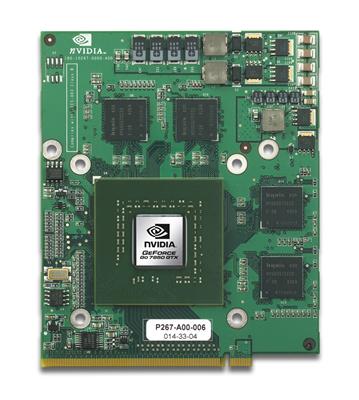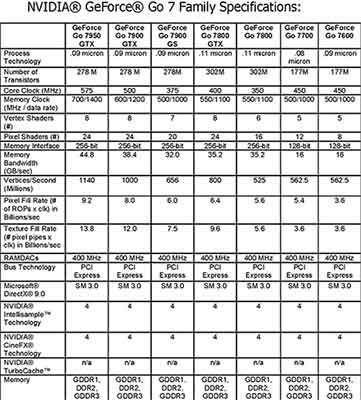Fall '06 NVIDIA GPU Refresh - Part III: GeForce Go 7950 GTX
by Ryan Smith on October 16, 2006 6:00 PM EST- Posted in
- GPUs
As the GeForce 7 series comes to a close with the impending launch of the G80 and the GeForce 8 series, NVIDIA has been fleshing out the last bits of its product line, setting up a unique GeForce card for nearly every price point. Last month we saw the introduction of the 7950GT and the 7900GS on the desktop, and this month the mobile space gets a new product with the introduction of the GeForce Go 7950 GTX.
As with the other products in the fall refresh, NVIDIA isn't introducing anything significantly new here and the Go 7950 GTX is no exception. As can be expected with the name change, the only differences here are the core and memory speeds, with NVIDIA taking advantage of the mature 90nm production process to bin faster chips that won't use more power. In this case the Go 7950 GTX is a drop-in replacement for the Go 7900 GTX, maintaining the same 45W power consumption rating. The 7950 GTX is clocked at 575/1400, compared to 500/1200 for the 7900 GTX, which results in the 7950 GTX being about 15% faster on paper than the 7900 GTX. Compared to desktop cards, it's clocked slightly higher than a base-speed 7950GT and should perform similarly.
Since this is just a speed bump, NVIDIA is still shooting for the desktop replacement market with the 7950 GTX. With some of these machines approaching a dozen pounds in weight, the goal isn't battery life or easy portability so much as it is how powerful a computer can be put into a laptop case. Accordingly, NVIDIA sees the target market for the 7950 GTX being LAN party-goers, who want to take their gaming computer with them but find full sized desktops and separate peripherals too much to move at once. These people also need to be willing to pay top prices for gaming laptops. Since these laptops won't be used away from a power outlet or on a lap often, the relatively high power usage and heat output of the 7950 GTX over NVIDIA's more power-conservative products isn't a problem.
NVIDIA is offering SLI support once again for the 7950 GTX, although they are not doing so immediately. Considering that most SLI GeForce Go setups are using the cooler 7900GS, this may have something to do with power, though we can't be sure. Also, NVIDIA is continuing to offer support for these high-end mobile GPUs in their official drivers so that gamers aren't stuck waiting on official vendor updates which can be a problem with new games requiring a driver update. Last, as with all NVIDIA mobile GPUs, the 7950 GTX does have PowerMizer support, so when it is running on batteries the GPU's power usage is kept in check.

While this is a hard launch, we do not yet have the hardware in our hands so we won't have any benchmarks. In-line with past GeForce Go launches Dell is currently the only manufacturer offering a shipping laptop with the new GPU, offering it exclusively on their XPS M1710. We took a look at an earlier revision of the M1710 back in April, so performance should be comparable, taking into account the use of a Core 2 CPU and the 7950 GTX. As of this writing there's an additional 4 day wait for M1710's using the 7950 GTX, so the supply is fairly tight for a hard launch. Dell is initially charging a $150 price premium for the 7950 GTX over the 7900 GTX, though we expect this to come down slightly as more manufacturers ship 7950 GTX-equipped laptops.
With the launch of the GeForce Go 7950 GTX, NVIDIA has effectively finished filling out its GeForce 7 product line. Although still slower than the fastest desktop cards due to the requirements of a mobile form factor, the 7950 GTX should be more than powerful enough to hold over most laptop gamers for now. The next significant performance increase will not occur until next year, after NVIDIA has launched the GeForce 8 series and starts producing mobile parts based off of it.
As with the other products in the fall refresh, NVIDIA isn't introducing anything significantly new here and the Go 7950 GTX is no exception. As can be expected with the name change, the only differences here are the core and memory speeds, with NVIDIA taking advantage of the mature 90nm production process to bin faster chips that won't use more power. In this case the Go 7950 GTX is a drop-in replacement for the Go 7900 GTX, maintaining the same 45W power consumption rating. The 7950 GTX is clocked at 575/1400, compared to 500/1200 for the 7900 GTX, which results in the 7950 GTX being about 15% faster on paper than the 7900 GTX. Compared to desktop cards, it's clocked slightly higher than a base-speed 7950GT and should perform similarly.
 |
| Click to enlarge |
Since this is just a speed bump, NVIDIA is still shooting for the desktop replacement market with the 7950 GTX. With some of these machines approaching a dozen pounds in weight, the goal isn't battery life or easy portability so much as it is how powerful a computer can be put into a laptop case. Accordingly, NVIDIA sees the target market for the 7950 GTX being LAN party-goers, who want to take their gaming computer with them but find full sized desktops and separate peripherals too much to move at once. These people also need to be willing to pay top prices for gaming laptops. Since these laptops won't be used away from a power outlet or on a lap often, the relatively high power usage and heat output of the 7950 GTX over NVIDIA's more power-conservative products isn't a problem.
NVIDIA is offering SLI support once again for the 7950 GTX, although they are not doing so immediately. Considering that most SLI GeForce Go setups are using the cooler 7900GS, this may have something to do with power, though we can't be sure. Also, NVIDIA is continuing to offer support for these high-end mobile GPUs in their official drivers so that gamers aren't stuck waiting on official vendor updates which can be a problem with new games requiring a driver update. Last, as with all NVIDIA mobile GPUs, the 7950 GTX does have PowerMizer support, so when it is running on batteries the GPU's power usage is kept in check.

While this is a hard launch, we do not yet have the hardware in our hands so we won't have any benchmarks. In-line with past GeForce Go launches Dell is currently the only manufacturer offering a shipping laptop with the new GPU, offering it exclusively on their XPS M1710. We took a look at an earlier revision of the M1710 back in April, so performance should be comparable, taking into account the use of a Core 2 CPU and the 7950 GTX. As of this writing there's an additional 4 day wait for M1710's using the 7950 GTX, so the supply is fairly tight for a hard launch. Dell is initially charging a $150 price premium for the 7950 GTX over the 7900 GTX, though we expect this to come down slightly as more manufacturers ship 7950 GTX-equipped laptops.
With the launch of the GeForce Go 7950 GTX, NVIDIA has effectively finished filling out its GeForce 7 product line. Although still slower than the fastest desktop cards due to the requirements of a mobile form factor, the 7950 GTX should be more than powerful enough to hold over most laptop gamers for now. The next significant performance increase will not occur until next year, after NVIDIA has launched the GeForce 8 series and starts producing mobile parts based off of it.










11 Comments
View All Comments
JarredWalton - Tuesday, October 17, 2006 - link
Regarding GeForce 7900 GTO (which I picked as an option in the latest http://www.anandtech.com/guides/showdoc.aspx?i=285...">High-End Buyer's Guide), it is not available for notebooks AFAIK. If you look at the chart, all of the GPUs are GeForce Go models, not regular GeForce models.